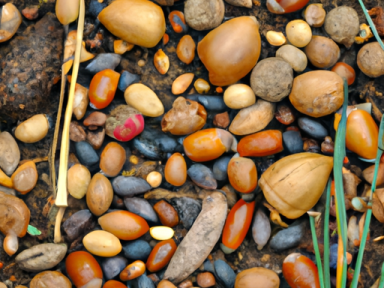
Nuts and Seeds: The Essential Survival Foods
Introduction
In times of crisis, having access to a reliable and sustainable food source becomes paramount. While stockpiling canned goods and MREs may seem like a sensible strategy, these items are finite and may eventually run out. To truly thrive in a survival situation, one must be prepared to forage and rely on the abundance of nature.
The Power of Nuts and Seeds
When it comes to foraging for food, nuts and seeds are essential resources that often go overlooked. Not only are they rich in protein, healthy fats, and essential nutrients, but they also offer a range of culinary uses that can elevate your survival meals. Let’s explore some of the most common nuts and seeds you can find in nature:
1. Acorns
Acorns are the nuts of oak trees and can be a lifesaver in a survival situation. While they require some processing to remove the bitter tannins, once properly prepared, they become a nutrient-dense food source. Acorns can be ground into flour for baking or used as a thickener in soups and stews.
2. Chestnuts
Chestnuts are delicious and highly nutritious nuts that can be found in abundance in forests. Unlike other nuts, they have a lower fat content but are rich in carbohydrates, making them an excellent energy source. Chestnuts can be roasted, boiled, or ground into flour for various culinary applications.
3. Pine Nuts
Pine nuts are the edible seeds of pine trees and are widely available in pinecones. These small but mighty seeds are packed with healthy fats, protein, and essential minerals. With a distinct buttery flavor, pine nuts can be enjoyed raw, toasted, or used in pestos and salads.
4. Sunflower Seeds
Sunflower seeds are a well-known and versatile seed that can be foraged from sunflowers. High in protein, fiber, and healthy fats, they provide a great energy boost. Sunflower seeds can be consumed raw or roasted, and their shells can even be ground into a flour substitute for baking.
5. Wild Hazelnuts
Hazelnuts, also known as filberts, can be found growing wild in many regions. These nuts are a fantastic source of healthy fats, vitamins, and minerals. They can be eaten raw, roasted, used in baking, or ground into a creamy nut butter.
Prepare for the Unexpected
While nuts and seeds provide essential sustenance in times of crisis, it is crucial to be aware of potential risks and challenges. When foraging, always ensure you are properly identifying edible nuts and seeds. Some toxic plants can have similar-looking nuts, leading to potential poisoning if consumed.
Furthermore, it is recommended to consult foraging guides specific to your region to learn about the various nuts and seeds available. Knowledge is power, and being able to identify and utilize nature’s bountiful offerings is a skill that can save your life.
Conclusion
Incorporating nuts and seeds into your survival food plan is a smart and sustainable approach to self-reliance. Their nutrient density, versatility, and availability in the wild make them an invaluable resource for any homesteader or prepper. By familiarizing yourself with the nuts and seeds in your area and learning how to prepare and incorporate them into your diet, you will be better equipped to thrive in any survival situation.



GIPHY App Key not set. Please check settings